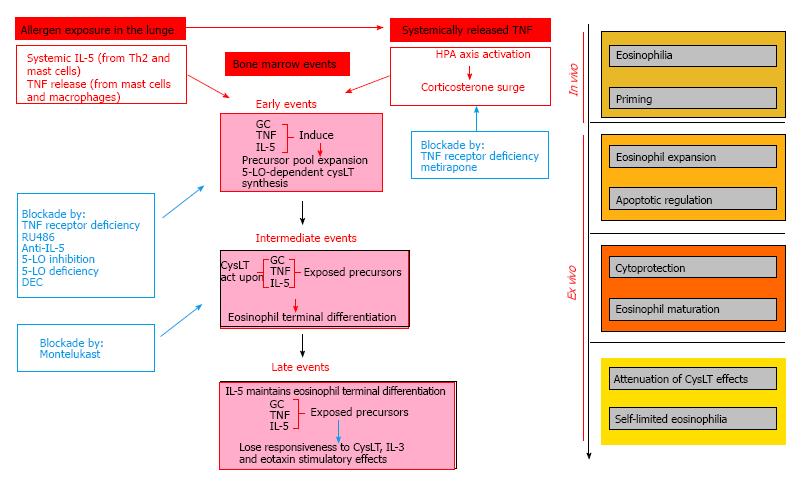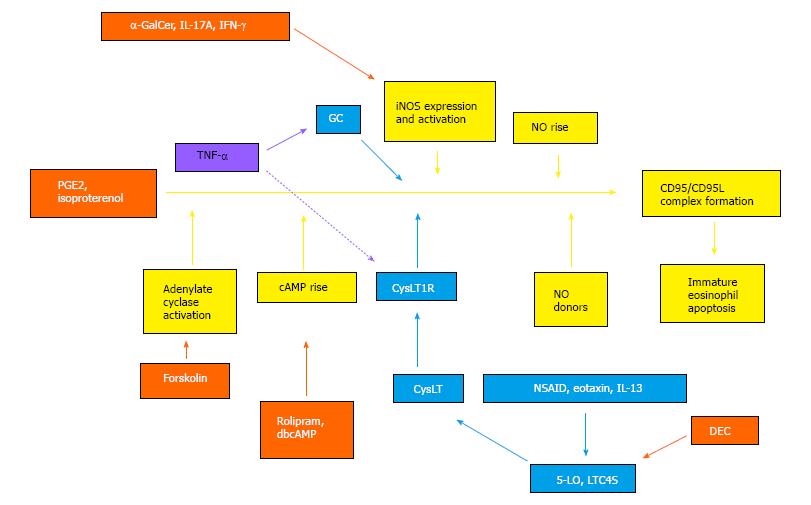Copyright
©The Author(s) 2017.
World J Exp Med. Feb 20, 2017; 7(1): 11-24
Published online Feb 20, 2017. doi: 10.5493/wjem.v7.i1.11
Published online Feb 20, 2017. doi: 10.5493/wjem.v7.i1.11
Figure 1 Events outside and inside bone-marrow following allergen challenge.
The sequence of critical events in the lungs, endocrine system and bone-marrow is outlined on the left as a flow chart, and their impact on the establishment of bone-marrow eosinophilia is depicted on the right as a timeline. On the left, we outline the contributions of cytokines (IL-5, TNF-α), adrenal GC hormones, and CysLT at early, intermediate and late phases after challenge, as have been characterized by genetical, immunological and pharmacological tools in bone-marrow culture (i.e., ex vivo; refs. provided in Table 1). Events promoting allergic inflammation are shown in pink boxes; interventions opposing allergic inflammation are shown in light blue boxes. Systemic events preceding the local bone-marrow response (left side, lungs; right side, endocrine system) are shown in red boxes. RU486 (mifepristone) is a blocker of GC receptor; metirapone is an inhibitor of adrenal GC biosynthesis. The combination of IL-5, TNF-α and adrenal GC is considered to be critical for the entire sequence of events in the bone-marrow, due to long-lasting effects of exposure during the initial 48 h of culture[51]. CysLT act downstream from GC[45,47] in the same sequence of events. Challenge promotes expansion of eosinophil precursors and their maturation in the presence of CysLT in vivo, but also attenuates responses to CysLT during subsequent exposure ex vivo, thereby limiting the magnitude of the resulting eosinophilia (represented in shades of orange at the right). TNF-α: Tumor necrosis factor-α; IL: Interleukin; CysLT: Cysteinyl-leukotrienes.
Figure 2 A graphical abstract of the main events identified in extrinsic regulation of bone-marrow eosinopoiesis, and of the hypothetical interactions of tumor necrosis factor-α with the underlying mechanisms.
Colored boxes and arrows identify different classes of agents and their actions as follows: Orange, extrinsic suppressors of murine bone-marrow eosinopoiesis both in vitro[23,26,72,73] and in vivo[47,54]; light blue, extrinsic enhancers of eosinopoiesis in vitro[25,36,51,70] and in vivo[45,47,52,53]; yellow, essential components of a proapototic sequence (iNOS-CD95L-dependent pathway[54,72,73]) which is susceptible to activation by the first (orange-labeled) and blockade by the second (light blue-labeled) sets of extrinsic regulators; lavender, TNF-α, presenting both constitutive (continuous arrow) and challenge-induced (discontinous arrow) effects, inside the bone-marrow, besides its extramedullary actions[45] as activator of the HPA axis (not shown). TNF-α: Tumor necrosis factor-α.
- Citation: Xavier-Elsas P, Masid-de-Brito D, Vieira BM, Gaspar-Elsas MIC. Odd couple: The unexpected partnership of glucocorticoid hormones and cysteinyl-leukotrienes in the extrinsic regulation of murine bone-marrow eosinopoiesis. World J Exp Med 2017; 7(1): 11-24
- URL: https://www.wjgnet.com/2220-315X/full/v7/i1/11.htm
- DOI: https://dx.doi.org/10.5493/wjem.v7.i1.11










